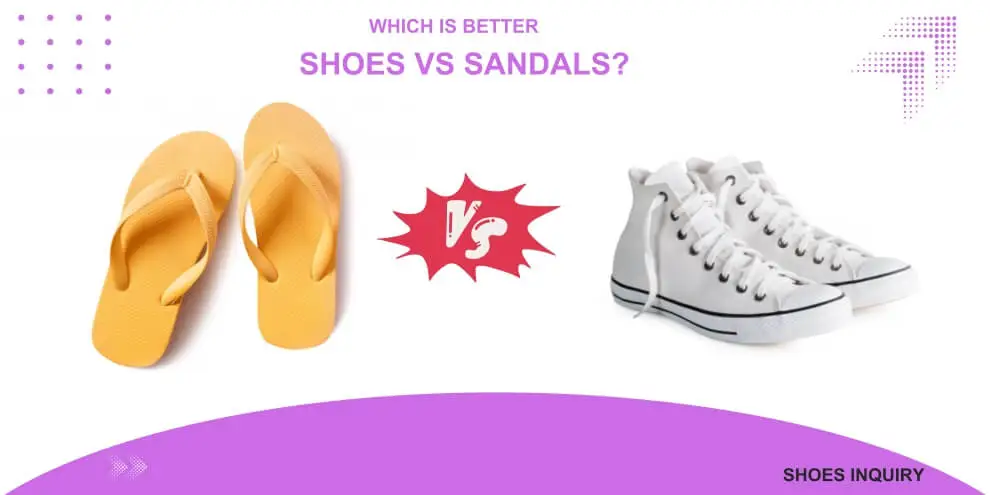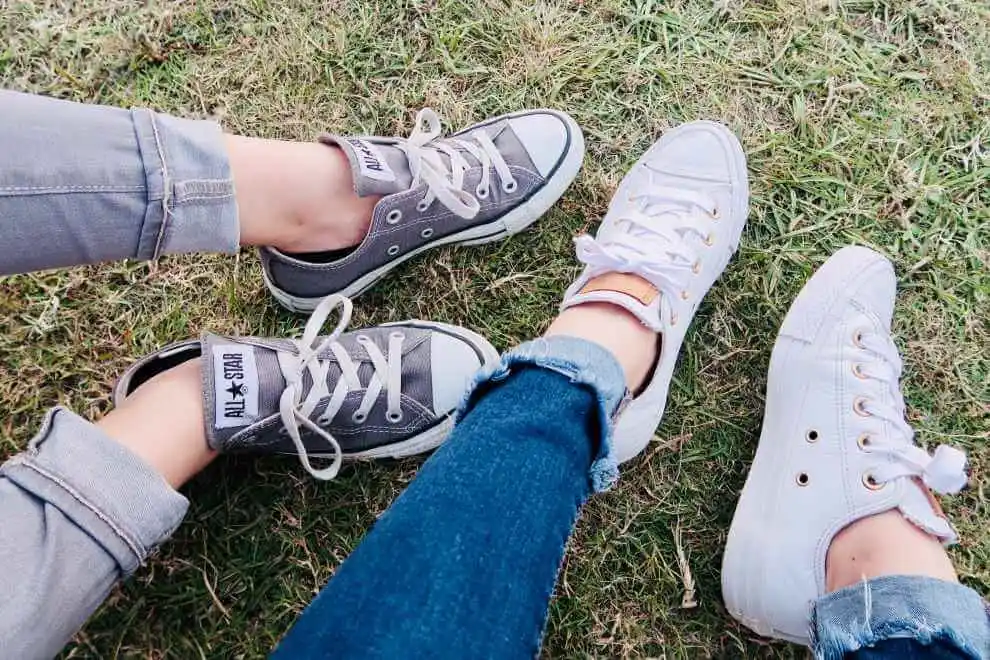Introduction
When selecting the right footwear, it’s important to remember that no universal solution fits everyone’s needs.
The choice of shoes greatly depends on the occasion or activity you are engaging in.
No matter what you’re doing, be it a casual stroll or a formal event, it’s crucial to have the appropriate footwear to ensure comfort, functionality, and style.
This article delves deeper into two popular options: shoes vs sandals. You will gain the necessary insight to confidently choose the footwear type that meets your specific requirements by examining its distinct features, advantages, and drawbacks.

Table of Contents
Shoes vs Sandals – The Difference
Shoes vs Sandals are two common types of footwear, but they couldn’t be more dissimilar. While sandals reveal some of your feet, shoes completely enclose your feet.
Shoes offer additional support and defense against cuts and splinters since they completely enclose the foot. Conversely, sandals allow your feet to breathe more easily. They are less supportive than shoes, which might harm how quickly your feet get weary after heavy or frequent use.
Shoes provide adequate protection for daily city life and various outdoor activities. At the same time, sandals let you feel fashionable on the beach or at more social events in warmer months.
Both have advantages for various occasions and styles.
Which is better?
Regarding footwear, the debate between shoes and sandals is a long-standing one. Although both provide comfort and style, each can be more versatile than the other, depending on the situation. Let’s look at how these two contenders measure against each other regarding comfort, style, and versatility.
Comfort
Shoes are frequently seen as the more comfortable choice for comfort. Shoes provide padding and support for your ankles and feet, which helps keep your feet from growing tired throughout the day.
Sandals may be cozy in some circumstances, but they lack arch support as shoes, which can wear out your feet over time. Some sandal designs, meanwhile, provide arch support and can be equally as comfy as shoes.
Ultimately, choosing shoes versus sandals for comfort boils down to personal preference.
Style
Both shoes and sandals have a wide range of available styles for you to select from. Different materials can be used to make shoes, including leather, suede, and canvas.
Moreover, sandals are available in various materials, including leather and fabric, enabling you to stand out from the crowd with a distinctive look. There are many colors and designs, making it simple to choose something that goes with any clothing or circumstance.
Versatility
Versatility is where shoes shine compared to sandals. Shoes are much better suited for activities such as running or hiking due to the added support and protection they provide your feet while doing these activities than sandals do.
Furthermore, they are great for colder weather because they help keep your feet warm while still looking stylish with all the options available today.
On the other hand, sandals are great for warm-weather activities like swimming or going out with friends due to their lightweight construction that keeps your feet cool.
Shoes and Sandals: Location-wise

It’s crucial to consider where you will wear them while choosing between shoes vs sandals. For instance, dress shoes are typically the ideal option if you intend to go out for a good supper.
However, sandals are certainly your best option for beach or pool parties. Remember that some places may need closed-toed shoes regardless of the season; for instance, some restaurants may require dressy attire and closed-toed shoes, even in the summer.
Shoes vs Sandals: Season-wise
The season also determines which type of footwear is best for you. Closed-toe boots or shoes are usually preferred during colder months like winter and fall since they keep your feet warmer than sandals.
On the other hand, open-toed footwear can provide some much-needed relief in the hot summer months! Sandals also tend to be easier to clean after swimming in puddles on a rainy day.
Choose Footwear That Is Right For You

People can express themselves through clothing by choosing the correct dress and attitude. The key to finishing the outfit is choosing the appropriate pair of shoes for the situation!
When attending formal events, you must take extra care and not just grab any old shoes from your closet. Choosing the right footwear is as important as choosing the right style to avoid unwanted attention or destroying an outfit.
On the other hand, extremely dressy footwear may make you appear overdressed or as if you are making an effort. Ensuring one has attire that works for any activity is important in creating polished outfits without wasting a lot of money.
Choosing the correct shoes for different occasions helps you feel stylish, increase confidence and create lasting memories that don’t feel embarrassing when reliving them!
What Not To Wear
Let’s explore the fact in terms of shoes and sandals, what we should wear, and what we should avoid!
Small or Oversized Shoes/Sandals

Size is important when deciding between shoes vs sandals! So that your feet are comfy all day, you want your shoes or sandals to fit comfortably.
Oversized shoes can make it difficult to walk or run, while too-small shoes can lead to blisters and pain. Before choosing shoes or sandals, measure your feet and always try them on first.
Damp Or Wet Shoes/Sandals
No matter if you’re wearing shoes or sandals, damp footwear can be dangerous and uncomfortable.
Wearing wet shoes/sandals can increase your risk of slipping and falling and lead to skin irritation and discomfort due to moisture build-up in the fabric of your footwear. Avoid wearing damp or wet footwear whenever possible; opt for dry options like leather or canvas.
Hard Sole Shoes
Hard-sole shoes such as dress boots, loafers, and platforms may not be ideal on hot summer days because they do not breathe well. They trap heat against your feet, causing discomfort and sweat build-up throughout the day.
If you must wear hard-sole shoes in the summer, wear breathable socks to help wick away moisture from your feet while providing a cushioning layer between your feet and the shoe material.
High Heels
Even though high heels may look fashionable, they don’t offer the best foot cushioning. They can be painful to wear without rest in hot temperatures.
High heels can also exert extra pressure on specific foot regions, potentially injuring the foot if worn repeatedly without rest days in between. If you prefer more comfort than high heels while still getting some height, consider wearing low-heeled wedges.
The benefit of wearing shoes over sandals

Shoes are often preferred over sandals because they provide protection and support for the feet. Shoes typically have stronger soles, which help cushion the foot from hard surfaces but also help protect it from environmental hazards like rocks and sharp objects found in nature.
Shoes usually cover most of the foot and ankles, keeping dirt and debris out. Shoes also offer stability when walking on uneven terrain, reducing or eliminating falls. Styles, colors, and materials vary greatly for shoes to suit all tastes, besides making them safer.
In the long run, shoes may cost more than sandals, but they will save you time, money, and, more importantly, injury.
Cost Range: Exploring the Price Spectrum of Shoes and Sandals
When shopping for shoes vs sandals, the cost is an important consideration for many consumers. The price range of shoes and sandals can vary significantly, offering options for different budgets and preferences.
Exploring the cost range helps individuals make informed decisions based on their financial capabilities and value expectations. Shoes and sandals in the lower price range are affordable.
These options are often characterized by simpler designs, basic materials, and less elaborate features. Despite not offering the same durability or advanced technology as high-end footwear, they can still provide satisfactory performance for casual or occasional use.
As we move up the price ladder, mid-range shoes and sandals offer a balance between quality and affordability.
Consumers can expect better materials, improved craftsmanship, and enhanced comfort features in this range.
Mid-range options often blend style, durability, and functionality, making them suitable for everyday wear and a wide range of activities. Premium shoes and sandals are available in the higher price range.
These offerings typically feature top-notch materials, meticulous craftsmanship, and innovative technologies. Premium footwear brands often invest in research and development to create cutting-edge designs prioritizing performance, comfort, and style.
These products are geared toward individuals who prioritize the finest materials, long-lasting durability, and the latest advancements in footwear technology. Ultimately, the price range of shoes and sandals enables customers to choose solutions that suit their demands and budget.
Shoes and Sandals: Innovation and Technological Advances
Innovation in footwear has led to the introduction of new features and technologies in shoes and sandals. These advancements focus on improving comfort, performance, and sustainability.
Innovations include cushioning and support systems, breathability, traction, customization, sustainability, and smart features. By embracing these innovations, footwear brands aim to meet the evolving needs of consumers and provide them with enhanced functionality and style.
Staying informed about these advancements helps individuals make informed choices that align with their specific requirements and preferences.
The benefit of wearing Sandals over shoes
Shoes vs sandals: both have their pros and cons. Shoes are great because they offer more protection for your feet but can be limiting and uncomfortable during the hot summer.
Sandals, on the other hand, allow some air flow to your feet so that you stay cool. They also offer more freedom of movement since many styles come with adjustable straps and an open-toe plate.
Due to their increased ventilation, sandals prevent the spreading of bacteria or warts between toes and cool your feet.
Ultimately, any type of shoe can provide great benefits in its own right. Still, sandals also offer comfort and health maintenance opportunities, making them a great everyday option during warmer weather.
Reviews and Experiences of Shoes and Sandals Based on User Reviews
For prospective consumers, user reviews and personal shoe and sandal experiences offer insightful information.
These first-person accounts detail sizing, comfort, fit, performance, and durability. People can thoroughly understand the benefits and drawbacks of a pair of shoes by taking into account several reviews and personal experiences.
Making informed selections is further aided by recommendations from reliable sources. But reading reviews with an open mind is crucial, considering personal tastes and confirming credibility.
Buyers can examine the compatibility of footwear and make more assured purchasing decisions by using insights from user comments.
Final Verdict
The final verdict on the battle between shoes vs sandals is that both have their merits. The better choice depends on the specific situation.
Regarding comfort, shoes generally come out on top, providing ample support.
However, sandals offer refreshing breathability for your feet in hot weather. It depends on personal preference, as some prefer the timeless appeal of shoes while others enjoy the relaxed aesthetic of sandals.
No style is right for everyone, so feel free to explore and embrace different styles to suit your needs and preferences.
